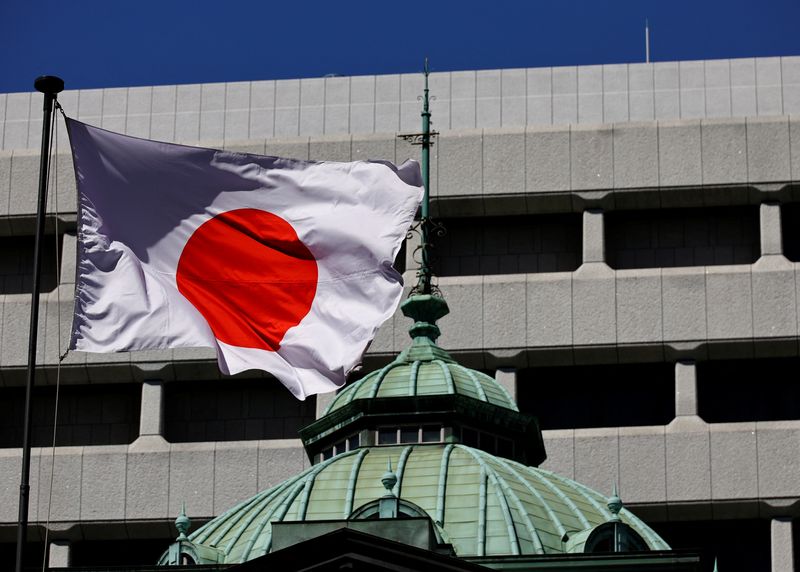By Leika Kihara
TOKYO (Reuters) - The Bank of Japan is laying the groundwork to raise interest rates again, but has left markets guessing how soon and at what pace it could push up still-low borrowing costs.
Here is a guide to the BOJ's recent communications on when and how far it could eventually raise interest rates:
WHAT HAS THE BOJ SAID AND DONE SO FAR?
The BOJ ended negative interest rates in March and raised its short-term policy target to 0.25% in July. In the latest sign another hike was nearing, BOJ Governor Kazuo Ueda said on Nov. 18 the economy was progressing towards sustained wages-driven inflation.
Ueda has also talked up the benefits of timely rate hikes, saying that pushing up borrowing costs from ultra-low levels would help achieve long-term economic growth.
The rhetoric is similar to that used during the BOJ's previous rate-hike cycle in 2007. Then governor Toshihiko Fukui had said phasing out stimulus early would help achieve stable, long-lasting economic growth by forestalling a bubble.
Under Fukui, the BOJ hiked rates twice from zero to bring them up to 0.5% in February 2007. But it was forced back into a rate-cut cycle the following year to combat the global financial crisis. Rates would remain around zero for another 16 years.
WHEN COULD THE BOJ NEXT RAISE INTEREST RATES?
Ueda is confident wages will keep rising and boost consumption, allowing companies to continue pushing up prices, meeting the prerequisite for more rate hikes.
While warning of U.S. economic uncertainty and market volatility, Ueda said the BOJ wouldn't necessarily wait until all such risks disappeared, which suggests he is open to hiking again at the next meeting on Dec. 18-19.
BOJ policymakers won't commit to a preset timing for the next rate hike. But they see no problem with markets pricing in a rate hike to 0.5% some time by end-March.
WHERE DOES THE BOJ SEE JAPAN'S NEUTRAL RATE?
If the economy continues to recover, the BOJ will keep raising its short-term policy rate towards Japan's neutral interest rate - or the level at which monetary policy is neither contractionary nor expansionary.
The BOJ keeps short-term rates at 0.25% even though inflation had hovered around 2% for well over two years, meaning inflation-adjusted, real borrowing costs remain very low.
By pushing up borrowing costs to levels deemed neutral to the economy, the BOJ can remove what it sees as excessive monetary stimulus.
But estimating the neutral rate, which cannot be observed, isn't easy with different models yielding varying results. Major central banks use neutral rates as a benchmark, but warn against overly relying on it in conducting monetary policy.
The BOJ has produced staff estimates using different models that show Japan's inflation-adjusted real neutral rate to be in a range of around -1% to +0.5%. That means if inflation were to hit the BOJ's 2% target, the BOJ can hike its short-term rate at least to around 1% without cooling growth.
Based on current forecasts made in October, the BOJ expects short-term rates to approach what it considers neutral "in the latter half of the three-year projection period" through March 2027, which suggests some time after October 2025.
While board member Naoki Tamura said in September the BOJ must raise rates to at least 1% as soon as late next year, his colleagues remain mum on the neutral rate level. Ueda has said it was too hard to come up with credible estimates due to a lack of data, as Japan had seen rates stuck at zero for so long.
WHAT ARE KEY TRIGGERS TO WATCH?
Neutral rates aside, yen moves will have a big effect on the BOJ's rate hike timing. A weak yen was one factor that prodded the BOJ to hike rates in July, as it pushes up the cost of imports and broader inflation.
Uncertainty over U.S. president-elect Donald Trump's economic policy also complicates the BOJ's decision. Many of his policies are seen as inflationary and may prevent the Federal Reserve from cutting interest rates too much, thereby keeping the yen weak against the dollar.
WHEN MIGHT THE BOJ OFFER MORE HINTS?
Consumer inflation data for October, due on Nov. 22, will be closely watched for clues on whether companies are passing on rising labour costs through hikes in services prices.

Toyoaki Nakamura, a dovish BOJ board member who is cautious about hiking rates too quickly, delivers a speech and news conference on Dec. 5.
The BOJ will release its "tankan" quarterly business survey on Dec. 13. If the data shows strength in business mood, capital expenditure plans and corporate inflation expectations, that could heighten the chance of a December rate hike.